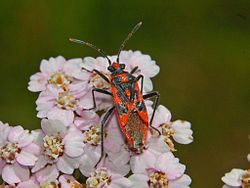- Corizus hyoscyami
| Corizus hyoscyami | |
|---|---|
 | |
| Corizus hyoscyami hyoscyami | |
 | |
| Corizus hyoscyami nigridorsum | |
| Scientific classification | |
| Kingdom: | Animalia |
| Phylum: | Arthropoda |
| Class: | Insecta |
| Order: | Hemiptera |
| Suborder: | Heteroptera |
| Family: | Rhopalidae |
| Genus: | Corizus |
| Species: | C. hyoscyami |
| Binomial name | |
| Corizus hyoscyami | |
| Subspecies | |
| |
Corizus hyoscyami is a species of scentless plant bug belonging to the family Rhopalidae, subfamily Rhopalinae. It is commonly called the cinnamon bug or black and red squash bug. [1]


